Starkey Hearing Aids Review: Best Options for Older Adults
Starkey hearing aids are known for their high-quality sound and tech-forward features. But they have special appeal for older adults with hearing loss. Find out why in our Starkey hearing aids review.

- Starkey has a long history of innovating the listening experience for hearing aid users.
- At $1,500–$4,000 per pair, the price of Starkey hearing aids varies widely depending on the level of technology, hearing aid style, and customization.
- There are six global hearing aid companies. Starkey is the only one of these top hearing aid manufacturers based in the United States.
- Starkey offers a wide variety of hearing aid styles and options, including rechargeable and disposable batteries, for a truly custom product.
- These hearing aids are available via prescription only.
NCOA supports everyone’s right to age well. That’s why we test and recommend products we believe can help you live a healthier life. We’ve spent more than 5,000 hours researching hearing aids to give you the most accurate product reviews. To find the best hearing aids, we:
- Consulted with audiologists, hearing instrument specialists, and aging care experts
- Put more than 50 hearing aids through a series of 21 different tests
- Mystery shopped more than 20 brands
- Surveyed hundreds of older adults who use hearing aids
- Interviewed experts on hearing loss
- Sent hearing aids to our friends and family with hearing loss to provide long-term testing notes
- Read thousands of verified customer reviews
We’re constantly testing new hearing aids to give you the most accurate and up-to-date recommendations. Read more about our hearing aid review methodology.
Prescription hearing aids are often recommended as the best hearing aids for those with moderate to severe hearing loss. That’s because they tend to be more powerful and can be professionally customized for your hearing profile. In our survey, 65% of older adults who purchased hearing aids did so from an audiologist or hearing clinic.1
But something a lot of people don’t know about prescription hearing aids is that there are really only six manufacturers worldwide, according to the Hearing Health Foundation.2 And Starkey is the only one of those based in the United States. In this Starkey hearing aid review, we take a look at what makes this brand and its hearing aids special, especially for older adults.
Starkey has developed many other innovations throughout its nearly 60-year history. In this Starkey hearing aids review, we take a look at their most recent platforms: Edge AI, Genesis AI, the Signature Series, and Evolve AI.
Why Starkey is a top brand for prescription hearing aids
Starkey started as a hearing aid repair business in 1967. Today, it remains a family-owned business, still based in Minnesota. It is also the only major hearing aid manufacturer based in the U.S.
The Starkey brand has a history of innovation in hearing aids, taking credit for developing the first in-the-canal style devices and the smallest rechargeable hearing aids. In that spirit, the company was among the first to use AI technology in hearing aids. The brand’s technology has continued to improve. Each generation of Starkey hearing aids grows closer to achieving natural-sounding speech even in the most challenging environments.
Ron Binkley, HIS, at Charlotte Speech and Hearing Center in Charlotte, North Carolina, likes that Starkey is a family-owned and U.S.-based company. He said the brand is “all about taking care of the patient.” He praised the customer support and noted that when he visited the Starkey factory in Minnesota, the quality control was top-notch. He saw how they test their rechargeable devices, which are waterproof up to one meter. “They do the three feet of water for a 30-minute test, and they show that to you,” he said.
Binkley also pointed out that Starkey has one of the only hearing aids that comes with a fall alert feature. The devices use motion sensors to detect a fall, and the app contacts the appropriate people. This extra layer of protection can be especially beneficial for older adults who are more prone to falls or those who live alone. A systematic review and meta-analysis found that adults with hearing loss have a 51% greater risk of falls compared with those who don’t have hearing loss.3
Like many prescription hearing aids, Starkey offers a variety of options to choose from. An audiologist or other hearing specialist is the best resource to guide you through finding a prescription hearing aid that best suits your needs. In this Starkey hearing aids review, we’ll provide an overview of the brand’s models and features.
Starkey
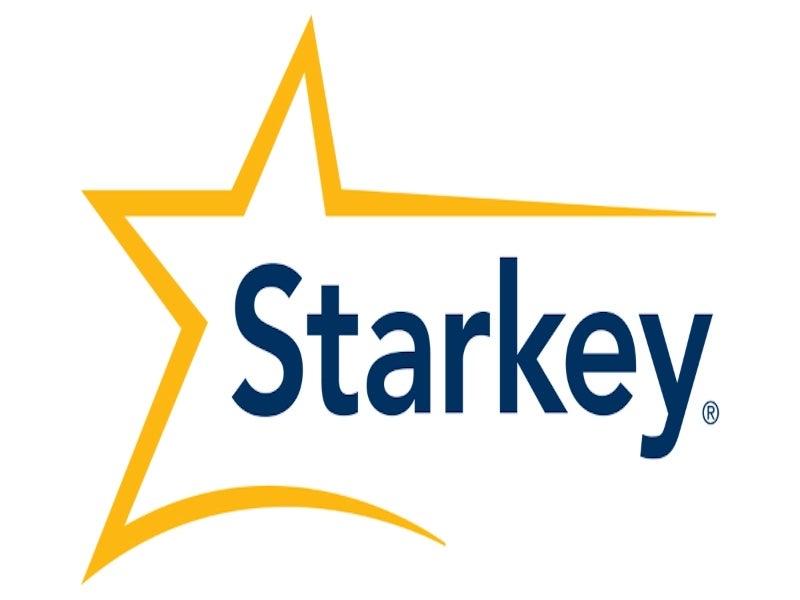
- Can be used for fall detection
- AI technology for better speech recognition
- Smartphone app for adjustments and wellness tracking
Comparing Starkey hearing aids
| Comparison Features | ||||
|---|---|---|---|---|
| Hearing aid type | RIC, Mini RIC, RIC 312, ITE R, ITE HS R, CIC |
CIC, ICIC |
ITC, CIC, ITC, ITE, RIC |
BTE, RIC, ITE, ITC, CIC, IIC |
| Battery type (disposable or rechargeable) | Rechargeable and disposable options |
Rechargeable and disposable options |
Rechargeable |
Rechargeable and disposable options |
| Bluetooth | Yes, Auracast |
No |
Yes |
On some models |
| Hands-free calling? | Yes |
No |
Yes |
On some models |
Understanding Starkey hearing aid models
All of Starkey’s hearing aids require a prescription. If you have a mild to moderate type of hearing loss, you might be able to consider OTC hearing aids. You can read more about them in our guide to the best OTC hearing aids.
In this review, we look at Starkey’s four most recent technology platforms: Edge AI, the Signature Series, Genesis AI, and Evolv AI. Below, we provide more detailed information about each of these platforms and their offerings.
Starkey Edge AI: The Latest Flagship Line
The Starky Edge AI is the latest release from the brand and a step up from the previous Genesis AI platform in terms of sound quality and connectivity. Edge AI’s advanced technology makes it easier to hear speech in noisy environments. This platform is also compatible with both telecoils and Bluetooth Auracast.
Starkey Edge AI
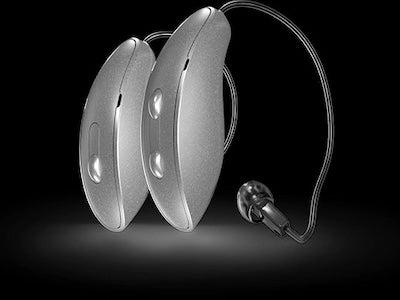
- Compatible with telecoils and Bluetooth (Auracast)
- Choice of disposable or extended-life rechargeable batteries
- Very durable, water- and sweat-resistant
- Type of hearing aid: RIC, ITE, CIC
- Battery type: Disposable and rechargeable options
- Bluetooth compatible: Yes
Pros
- Clearer speech in noisy environments
- 51-hour rechargeable battery life and energy-efficient when streaming
- Great connectivity, compatible with telecoils, Bluetooth, and Auracast
Cons
- Premium pricing
- Not self-fitting
What’s different about the Edge AI
The Edge AI platform is the next step forward in natural-sounding speech for Starkey, offering many of the same features users love about the Genesis AI platform. That includes a comprehensive app with unique features, including fall alert, health tracking, and real-time language translation. The biggest upgrade of the Edge AI series is its use of next-generation technology to enhance sound quality in noisy environments.
Previous Starkey platforms use AI to automatically adjust sound as the noise level of your environment changes. This can be useful, for instance, when moving from a noisy restaurant to the quiet sidewalk outside. The Edge AI claims to be even better at this task because, unlike its predecessors, its hardware was designed for use with AI. That means those functions can be carried out more quickly and efficiently. We did not test an Edge AI device, so we cannot comment on sound quality. But the brand rates the speech recognition in loud settings as 30% better with the Edge AI than with the Genesis AI series.
Edge AI hearing aids have other notable upgrades, including compatibility with both telecoils and Auracast. Auracast is a newer Bluetooth technology that allows for clearer audio streaming to devices compared to previous versions. Edge AI also works with Bluetooth Low Energy, which helps extend battery life when streaming. Starkey hearing aids featuring Edge AI technology with rechargeable batteries typically last up to 51 hours, but streaming is known to drain the batteries faster.
The Edge AI line was also designed for more durability than its predecessor, Genesis AI. It uses a system called Pro8 HydraShield to make the hearing aids highly resistant to sweat, rain, dirt, and other elements (more than the industry’s highest rating of IP68). Some devices are even waterproof up to one meter.
Starkey Signature Series: Custom Fit Hearing Aids
The Signature Series from Starkey features the brand’s custom-fit, in-the-ear, rechargeable models. These hearing aids pack Starkey’s advanced sound quality into a nearly invisible device. Like many ITE or CIC hearing aids, this line does not include Bluetooth streaming due to its small size.
Starkey Signature Series
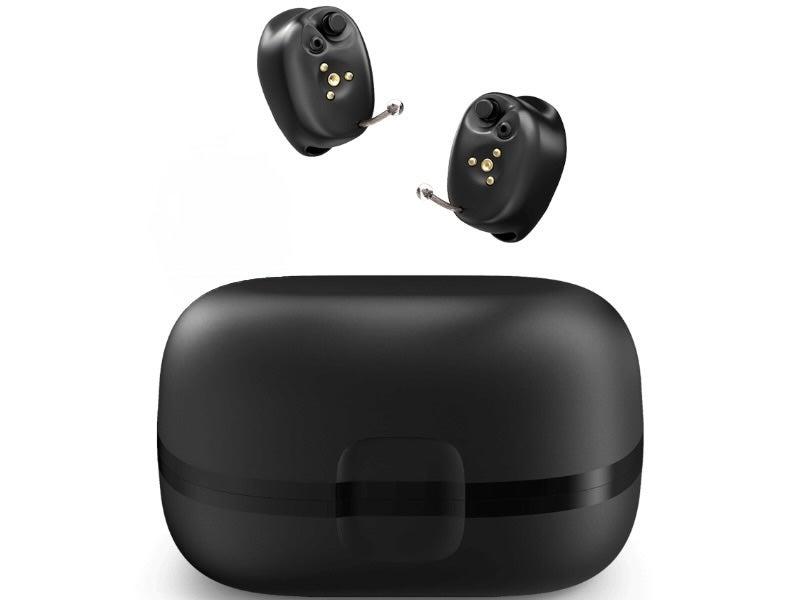
- Discreet profile
- Choice of disposable or rechargeable batteries (with up to 38-hour life)
- Waterproof options
- Type of hearing aid: ITC, CIC, ITC
- Battery type: Disposable or rechargeable
- Bluetooth compatible: No
Pros
- Very small and discreet
- Quality sound processing
- Custom fit
Cons
- No Bluetooth streaming or app connectivity
- Small size may pose problems for people with vision or dexterity issues
- ITE devices are more prone to wax buildup and require regular cleaning and a dryer
What’s different about the Signature Series
The Starkey Signature Series line was the first to feature custom-fitting, in-the-ear style hearing aids. It was released in 2024 and includes a CIC style with disposable batteries, another with rechargeable batteries, and the most discreet option, an invisible CIC style. For more information on discreet options, you can refer to our guide to the best invisible hearing aids.
Like the Genesis AI platform, which was released the previous year, the Signature Series uses more advanced sound processing technology to achieve clear speech and reduce background noise in different settings. The Signature Series is designed with two features for clearer sound: EdgeMode+ automatically adjusts to changing levels of background noise, and motion sensors detect when the wearer is moving. When that happens, the sensors redirect the directional microphones to capture the best sound with the least interference from wind or feedback.
The Signature Series emphasizes a small size and discreet fit, resulting in a tradeoff in battery life and features. The Signature Series rechargeable battery model has a 38-hour life, compared to 51 hours for the Edge AI and Genesis AI. Most Signature Series devices also lack Bluetooth streaming capabilities. But they can be a great choice for anyone seeking premium sound and a nearly invisible device.
Starkey Genesis AI: The Fast-Adapting Hearing Aid
The Starkey Genesis AI uses AI technology to automatically adjust to noise levels in real-time. Its processor is smaller and significantly more powerful than previous models, and its battery life is among the longest.
Starkey Genesis AI
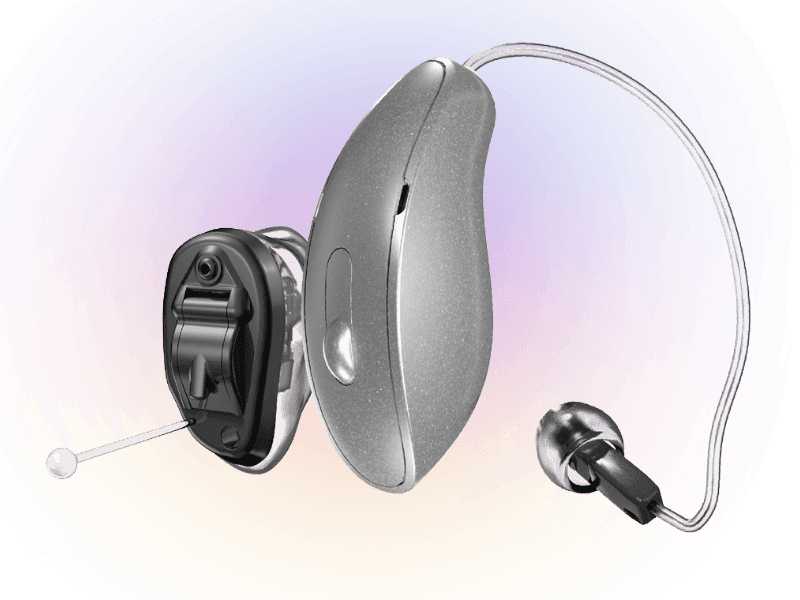
- AI-powered auto sound adjustment for clear speech
- Tinnitus-masking features
- Long rechargeable battery life
- Type of hearing aid: IIC, CIC, ITC, ITE, RIC
- Battery type: Disposable and rechargeable
- Bluetooth compatible: Yes
Pros
- Uses AI to auto-adjust for natural-sounding speech in noisy places
- Many discreet options (IIC, CIC, ITE, RIC)
- Comprehensive app with unique features (fall detection, health monitoring)
Cons
- Bluetooth streaming is only available on some models
- Requires an accessory to connect to a laptop or TV
- No “own voice” technology
When it was released in 2023, the Starkey Genesis AI boasted the most powerful AI capabilities on the market. This feature allows these hearing aids to adjust to various sound environments automatically. Its technology is an upgrade from the older Evolv AI platform. Genesis AI’s more powerful processor allows it to automatically adapt to the noise level of a place, stream Bluetooth, and more. It also has one of the longest-lasting batteries out of some of the best rechargeable hearing aids on the market, up to 51 hours.
We tested the Genesis AI RIC unit, and our testers said it fit comfortably right out of the box. “They’re very comfortable, lightweight, and feel secure in my ear,” one tester said. “I had no problems fitting it right away.” The devices stayed in place and felt fine even during light exercise. “The setup was really easy and the user manual was surprisingly helpful,” a tester said. Manuals for prescription hearing aids tend to have much more information than OTC manuals and lack simple-to-follow directions, so this was refreshing.

Our testers also appreciated the app. Previous platforms used the Thrive app, but the new My Starkey app was designed with input from people who wear hearing aids. It has some of the same features as Thrive, including fall detection and personal health tracking. Unlike Thrive, the My Starkey app is compatible with Apple watches. “People who aren’t tech-savvy may find the app complicated and need help setting up some features, like fall detection,” one tester said. “But it’s got lots of options—activity tracking, adding goals, the find my hearing aids feature, and more.” The Genesis also works with the Hear Share app, which caregivers (or others the user designates) can use to view hearing aid data.

One of the few drawbacks our testers found with the Starkey Genesis was that it lacks “own voice” technology, which is a feature common among prescription brands, including Phonak. This feature helps process the sound of your own voice, so it sounds more natural. But the Genesis has many other premium features, as well as great audio performance in noisy environments.
Starkey Evolv AI: An Option for Every Style
The Starkey Evolv AI is one of the earliest platforms to use AI-powered programming, automatically adjusting sound levels according to your environment. There are many different hearing aid styles to choose from, and, thanks to the app, users also receive bonus features such as fall detection and personal health and fitness tracking.
Starkey Evolv AI
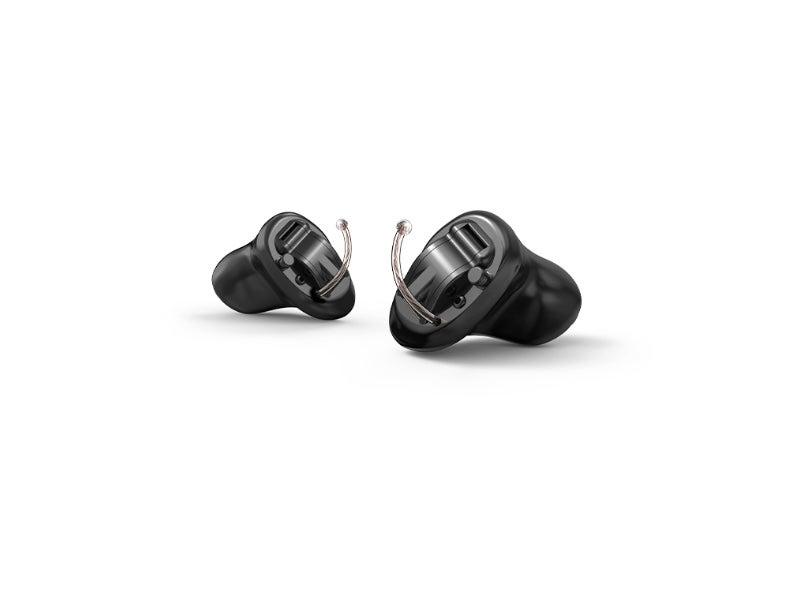
- Smart sound processing with AI-powered auto-adjust features
- App with fall detection, personal health and fitness tracking, and more
- Bluetooth streaming
- Type of hearing aid: BTE, INT, ITC, CIC, IIC
- Battery type: Rechargeable
- Bluetooth compatible: Yes
Pros
- Wide range of styles available
- Tap control
- Bluetooth streaming and app control
Cons
- No indicator light when charging
- Battery life is not as long as that of other models
- Some features, like Edge Mode Plus, require manual activation
What’s different about the Starkey Evolv AI
Starkey has been using AI technology to power its hearing aids since 2018. The Evolv AI, launched in 2021, uses this technology to reduce noise and refine speech clarity by automatically adjusting to the current noise level. The platform is available on a range of models, including both behind-the-ear and in-the-ear styles. Most are fairly discreet and feature premium options, such as Bluetooth streaming, although the quality of this feature may not be as good as that of later Starkey models.
The Evolv does have a shorter battery life, around 24 hours. Both the Edge AI and Genesis AI have a battery life of 51 hours, the longest in Starkey’s lineup. Like previous platforms, Evolv AI has fall detection and activity tracking, but uses the Thrive app. Later models use the My Starkey app. We did not test the Evolv AI or Thrive app, but it features built-in sensors that detect a fall and can alert up to three personal contacts with your GPS location. Falls are the leading cause of injury for adults age 65 and up, so this feature could be very useful.4 Research has found that devices with fall detection are most effective when worn on the upper part of the body, as hearing aids are.5
Technology always moves fast, and Starkey has platforms with more updated noise reduction and connectivity, but the Evolv AI remains a good option with premium features.
How much do Starkey hearing aids cost?
Like most prescription hearing aid manufacturers, Starkey does not publish prices on its website. Generally, Starkey tends to be comparable in price to other top brands, such as Phonak and ReSound. For specific pricing information, you need to speak with a local hearing care professional who sells Starkey hearing aids. That said, the newer the model and technology in a hearing aid, the higher the price you can expect to pay. The chart below shows the impact the technology used in hearing aids can have on the price.
Most insurance plans, including Medicare Part A and Part B, do not cover the full cost of hearing aids. Medicare Advantage (Part C) may cover some of your hearing aid costs.6 If you have a Health Savings Account (HSA) or Flexible Spending Accounts (FSA), you may also be able to use those for the purchase of hearing aids. Check with your insurance provider to see what’s covered.
| Prescription Hearing Aid Technology Level | Price Range per pair |
| Premium | $10,000–$6,000 |
| Advanced | $9,000–$5,500 |
| Standard | $7,500–$4,500 |
| Essential | $5,800–$4,000 |
| Base | $5,500–$3,500 |
Starkey smart features and connectivity
The Starkey brand has consistently incorporated the latest technology into its devices to enhance the user experience. Here are some of the features that help with that:
- G2 Neuro Processor: The G2 Neuro Processor is the brand’s newest technology. It is an integrated processor used in the Edge AI platform (past platforms used a chip) for better sound processing in challenging or noisy environments. It helps automatically adjust sound levels to make speech sound more natural.
- Neuro Sound Technology 2.0: Another feature exclusive to the Edge AI, Neuro Sound Technology 2.0 helps imitate how the brain naturally processes sound. Starkey claims it improves speech recognition and minimizes background noise interference.
- TeleHear: Unlike many OTC hearing aids, Starkey’s are not self-fitting. Telehear is the system the brand uses to remotely fit people and make small adjustments to improve their hearing. It eliminates the need for an office visit to adjust your hearing aids.
- Auracast: Auracast is a newer Bluetooth technology that is designed for streaming audio to devices. It works like a telecoil, but because it was designed for sound, it is clearer and more efficient, so it won’t drain rechargeable batteries as quickly. The Edge AI is compatible with Auracast.
- Mobile apps: We were consistently impressed with the features included in the Starkey apps. The initial app, Thrive, will alert your contacts in the event of a fall, can translate speech, features a "Find My Hearing Aids" function, and more. The My Starkey app, which works with hearing aids that use the Genesis AI or Edge AI platforms, includes many of the same features and an updated user interface design. Starkey devices are also compatible with Hear Share, an app that allows caregivers or people you choose to view the data.
Starkey hearing aid accessories
Starkey hearing aids come standard with a charging case or batteries, a carrying case, cleaning tools, and informational literature or manuals. But you can purchase optional hearing aid accessories to enhance your listening experience. Here are some that Starkey offers:
Remote microphones: Starkey offers a range of cordless, rechargeable microphones compatible with its devices. They can be clipped on or placed near a speaker or other sound source to stream sound directly to your hearing aids for clearer speech. Some models double as a remote for controlling the hearing aids.
TV streamers: Starkey TV streamers allow you to wirelessly stream audio from the television directly to your hearing aids. Some models work with digital and analog signals. Newer models are compatible with Auracast and Bluetooth Low Energy protocol, which may help extend the battery life of your hearing aids.
Are Starkey hearing aids right for you?
Starkey makes prescription hearing aids for people with mild to profound hearing loss. The brand is known for its range of discreet styles and use of cutting-edge technology to improve the listening experience. The brand was an early adopter of AI and other smart features that may specifically benefit older adults, like motion-sensor fall detection. When deciding whether to purchase Starkey hearing aids, consider:
- How severe is your hearing loss? Starkey hearing aids are designed to treat mild to profound hearing loss. They require a prescription from a hearing specialist to purchase. If your hearing loss is mild or you have trouble only in certain environments, you may want to consider a more affordable hearing aid.
- Are you spending most of your time in quiet places or noisy ones? Starkey has many features to make sound clearer in challenging environments and to adjust noise levels. You may not need those features if you are typically in a quieter setting with few people.
- Do you have vision or dexterity issues? Starkey offers a variety of hearing aid styles, with most models being small for a discreet appearance. That can make using and maintaining them more difficult if you have trouble with your eyesight or handling small parts.
- Do you enjoy streaming media directly to your hearing aids? Most Starkey devices can stream audio and deliver high-quality sound without draining battery power too quickly. But you will pay for such features.
- Do you worry about falls, or do you work with a caregiver? The My Starkey app has features designed to alert others in the event of a fall and allow data to be shared. These features may benefit older adults who have other health issues in addition to hearing loss.
- What is your budget? Prescription hearing aids tend to be pricier than OTC ones, and Starkey is on the higher end. It offers a lot for the price, but if you prefer a simpler hearing aid, there are other options.
Frequently asked questions
How much do Starkey hearing aids cost?
Starkey hearing aids range in price from $1,500–$4,000 per pair. Starkey does not publish its prices on its website, but these prices tend to be comparable to those of other top brands, such as Phonak. For specific pricing information, you need to speak with a local hearing care professional.
Does Starkey make good hearing aids?
Starkey is considered one of the top manufacturers of prescription hearing aids, and our testers found that the brand delivered high-quality sound and premium features.
How do Starkey hearing aids compare to other leading brands?
Starkey hearing aids are among the top prescription hearing aid brands. They are known for their quality, premium features, and use of technology to create a better and more natural-sounding experience. They are comparable in cost to other top brands.
Do Starkey hearing aids have tinnitus features?
Yes, Starkey hearing aids have a customizable sound stimulus that can be adjusted to mask tinnitus sounds. Starkey also offers an app called Relax, which features 12 different soundscapes that can be downloaded to help manage tinnitus.
Questions? Email us at reviewsteam@ncoa.org.
